► A guided tour of the Porsche Museum
► Design chief Michael Mauer is our guide
► Join Gavin Green on a Porsche pilgrimage
Our tour guide for the Porsche Museum (4.5 stars out of five on TripAdvisor, the second highest rated museum in Stuttgart) is Michael Mauer, Porsche’s chief designer. Towards the end of our tour, Mauer is showing us the many cars he was responsible for designing. They include the 991 and 992 versions of the 911, the 918 Spyder, the Macan, the Panamera and the latest 718-generation Boxster and Cayman. In fact, every new Porsche since he took over as design boss in 2004, replacing Dutchman Harm Lagaay.
Michael Mauer showing us around the Porsche Museum is a bit like Salvador Dalí or Andy Warhol giving us a tour of the Tate Modern, or Caravaggio showing us around the Uffizi. A star showing us his work and those of his peers. Porsche has had only four design directors in its history. The first was Ferdinand Alexander Porsche, eldest son of company founder Ferry and credited with the original 911.
‘Change helps to keep an organisation young and fresh but, on the other hand, there is the risk you lose the connection from one car to the next. I believe if you want to build a strong brand identity, you need continuity. I’m happy that while most of the car industry, like the fashion industry, has been trying to make quite radical styling changes quite quickly, we’ve resisted. Sometimes it takes more courage not to do everything that new technology makes possible. I’m very happy Porsche didn’t fall into this trap. We have an anchor in this fast-changing world. I believe there’s no point changing unless it’s to make it better.’
We tour from the very beginning of Porsche’s car-building days – the late ’40s – and Mauer dwells on the 356, Porsche’s first car. ‘It’s a pure, simple design that took courage and skill. If a car’s surfacing isn’t right and the stance isn’t right that’s when designers add one line, then another and in the end you don’t even know what the car should look like. Many cars fall into that trap today. But the 356 was so right and many of its design elements lasted for the next 50 years.’
We drive the Porsche 356 – the original Porker
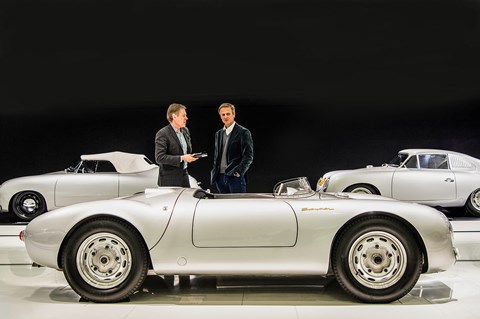
We move onto the 550 Spyder from 1953 (above), the type of car in which James Dean was killed, when he hit Donald Turnupseed’s Ford sedan on Route 466 near Cholame, California. It’s small, light (just 550kg) and mid-engined. Would he like to design a new, smaller, more minimalist sports car – a modern 550 Spyder? ‘I’d love to do a pure new sports car, reduced to the maximum. We will see. There is a lot of discussion. I think it’s possible, especially with new materials.’ He talks about such a car potentially being ‘mechanical, pure and back to our roots’.
Porsche is still a pure sports car maker at heart, insists Mauer. He makes this point early in our museum tour, perhaps to head off the obvious question before we get to the Cayennes and Macans. Nowadays, 65 per cent of Porsches built are SUVs. The Macan and Cayenne are the two best sellers. ‘There’s nothing wrong with a brand growing. But you need a clear design philosophy and, in Porsche’s case, we still need the “real” sports cars that are the core of the company.’ He cites the 911 and its endless performance iterations – ‘no other company manages its derivative strategy so nicely’ – plus the 718 Boxster and Cayman, great sports cars all.
We move on to the 904 (1964), Porsche’s mid-’60s sports racer, and a Mauer favourite. ‘Ferdinand Porsche is most famous for the first 911. But this [the 904] was his masterpiece. It also subscribes to the Porsche philosophy that to be more efficient, go smaller and lighter.’
But with chunky Cayennes and 1500kg 911s, is that still Porsche’s philosophy? ‘Yes it is,’ he insists. ‘With the Panamera and Cayenne, we have to offer luxury and equipment that these customers expect, and that adds weight. Lightweight is still our focus. Moving forward, with battery-electric cars, reducing weight will become even more important.’
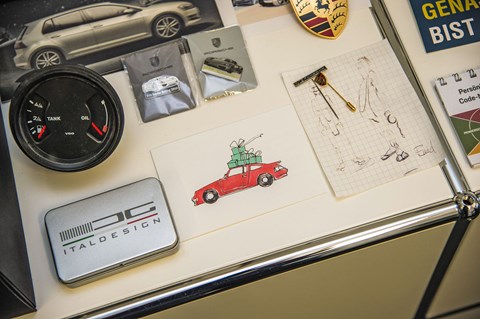
We come to the first 911 (1963), which nowadays looks almost impossibly small and dainty. ‘A step forward on the 356 and you can see the connection: the side window shape, upright screen, simple and taut surface treatment, high front fenders… a very modern car but with a clear connection to the 356 and this is how they started to build the brand identity. That was very far-sighted, especially for a young company. They could have tried to do something all-new with the 911 but they didn’t make that mistake. They only got it wrong once – the 928 [1978].’
Ah, the 928! One of the all-time great luxury GTs, the only sports car to win European Car of the Year, LJK Setright’s favourite Porsche (in fact, the only Porsche he ever liked) and Porsche’s first all-new sports car (even the 356 had Beetle genes). And a big marketing mistake. ‘The 928 was supposed to replace the 911 [whose sales dipped in the mid-’70s]. Then some clever person realised that was not the right strategy.’
But what a car! ‘Yes, incredibly brave. Integrated bumpers, that soft nose, adjustable steering wheel and instruments, pop-up headlamps. Who else was doing a car like that? Nobody. That car was maybe too modern, maybe the most modern Porsche ever. Porsche thought that was the way to go, not the 911. I think we can be very happy that didn’t happen.’
Then, the 917 (1969), a twice Le Mans winner and the car that elevated Porsche into the top-tier supercar league. Mauer says he’d love to drive one. I tell him I have. He cites the aerodynamic functionality, which made the car look the way it does, and its ‘industrial’ design. ‘You can see the structure, the way it’s made. Nowadays we cover everything. That’s such a shame.’
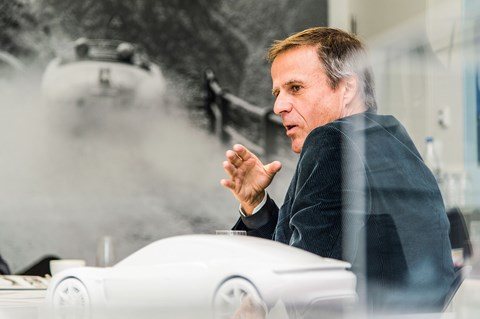
He says these old Porsches taught him a lot. ‘You need to push forward the design language but without losing contact with your history. Whenever we design a new 911, I say first of all, everyone has to recognise that it is a 911 and, second, we need to create a design that lets people know it is a new one. It’s hard. How far do you go? Do you go too far? It’s our most cautious car. It’s our most difficult car to design and, at the same time, the most exciting for a designer. This is our core product. It also defines our corporate design language.’
His single favourite Porsche? ‘The 964 [third-generation 911, of 1988]. I guess it’s inevitable when you work for Porsche that your favourite Porsche is a 911.’ He says most people say the 993 [1993] is the best 911 but he thinks the front conflicts with the centre section, like two cars in one. ‘The 964 has so much of the original 911 and the bumpers are more integrated. It’s the perfect connection to history but shows real modernity.’ He owns three 964s: a coupe, a targa and a cabriolet.
We finish our tour with the Le Mans-winning [2014-2017] 919 sports racer, an ugly bug after the graceful birds we see earlier. ‘To design this type of car is not fun. It’s all to do with aerodynamics and regulations. The only thing we could influence was the graphic on the side. Even the strong four-dots headlight of the first-generation 919 – a Porsche feature – was replaced after the first season. The racers said they needed better lights so we got the same lights as Audi. It is so much driven by functionality. The old cars were less driven by regulations and science.’
The new electric Taycan was conceived using Porsche’s time-honoured philosophy: modern but acknowledging the rich past. ‘From a design view, I’m very happy Porsche went into the BEV [battery-electric vehicle] market. It opened a window. It’s much more than an evolution. We had to visualise a new decade and be more progressive.’
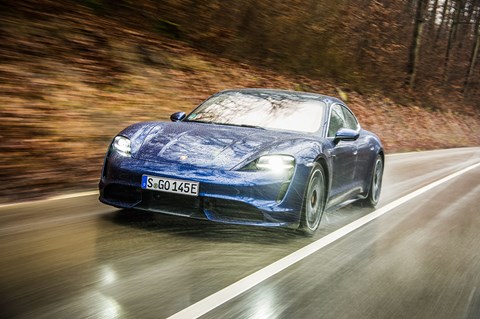
We drive a Taycan Turbo the 30 minutes or so north-west from the historic factory and museum in Zuffenhausen, in northern Stuttgart, to the engineering and design headquarters in Weissach, just outside the city. Mauer says the greatest design achievement of the Taycan is its height-to-width proportion, especially its lowness.
‘It’s the first electric vehicle with these dramatic proportions [the Taycan is 1387mm tall, versus 1445mm for Tesla’s Model S]. The problem with having batteries in the floor [as nearly all electric cars do, to keep the centre of gravity low] is that it makes for a high car, and that’s not very sporty. The engineers came up with the idea of cut-outs in the floor, where you don’t put batteries, so people can sit lower. Plus, the batteries are very well packaged. This helps the handling and driving because the batteries are as low as possible, and it helped the design.
‘SUVs can accommodate batteries more easily, because they’re high. The safe bet for Porsche’s first BEV would have been an SUV, because the cake is bigger. But we had to prove that electric cars can be true sports cars.’
As electric cars progress, so Mauer believes he’ll enjoy more design freedom. ‘As components and batteries get smaller, that will open packaging and design opportunities. It’s a bit like mobile phones. In the beginning they were like boxes. Now everything is smaller and the technology does not define the size.
‘We are in a transition phase for electric cars. We’ll miniaturise parts and this will create more design freedom. But the brand is still so important. On Porsches, we have high centre consoles and high beltlines, to give a feeling of sitting in the car, not on the car. Now you come to the point where maybe you don’t need the high centre console. But you do it for the brand identity. Tesla can have clean, open interiors. But we have to be conscious that people are driving a Porsche.’
He tells me he finds Tesla interior design much more interesting than its exterior design. ‘But let’s face it, without Tesla, the traditional automotive industry would not have made such electric-car progress.’
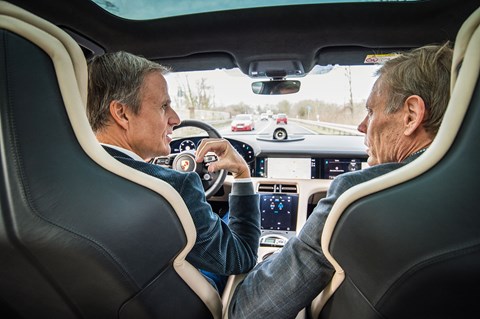
The greater uniformity of electric cars, and the move towards autonomous driving, present challenges. ‘A great brand such as Porsche needs three qualities. Can you see the difference? Can you feel the difference? Can you tell a story around it? The latter is why people in America, China and Switzerland, who never drive fast, want a car with 600 horsepower. There’s a story behind it. Moving forward, the function and feel become more challenging, design becomes more important and, if you can no longer drive fast, then the story around the brand becomes more important, too.’
Mauer is 57 and was brought up in the Black Forest, not far from Porsche’s Stuttgart home. He spends as much time as possible outdoors and looks tanned and fit, no surprise when he tells you he spends most weekends during the winter skiing, often at his own place in Switzerland. This is why he doesn’t drive a Taycan as his everyday car. ‘The problem is the range. It’s too far when I go skiing and charging there can be difficult. Plus, I often go last minute, so being limited by the car’s state of charge would be a nightmare.’
Rather, his day-to-day transport is a Panamera. ‘I used to have 911s. But skiing and mountain biking are my passions, so I need space for my sports gear. I could have had a Cayenne or a Macan but the Panamera is more sporty. I’m not an SUV man. I like a car that’s low and wide. The Panamera is a sports car with space.’
We arrive in Weissach and go to Mauer’s office. Model cars line one of his walls, many miniatures of cars he has designed. ‘Weissach is really in the middle of nowhere and I live about 40 minutes’ drive from here, in the countryside. I get my inspiration not from city museums or art galleries but from being in the country, on my own, spending a couple of hours on the mountain or in the forest.’

Mauer has worked for three car makers, Mercedes-Benz (including Smart), Saab (briefly, as design chief, under General Motors) and now Porsche. ‘After school I didn’t know what to do, although I had dreams of becoming a ski instructor. My dad, who was a doctor, had a friend at Mercedes-Benz and asked him whether there was a profession that combined art, at which I was good, and a love of cars. He said, yes, a car designer. I got an internship at Mercedes in 1986.’
The great Bruno Sacco, design boss of Mercedes from 1975 to 1999, was his mentor. Sacco’s style prioritised surfacing, proportions and stance. It made Merc design timeless (not true today, and not true of many other car makers, either). ‘He taught me the importance of building a brand by consistent design, and of “reductivism” – no decorations, clean surfacing.’
Sacco also believed in design continuity, from model to model, and from generation to generation. This has underpinned Porsche design from the very beginning. It’s clearly a Mauer long-time signature, too.
‘Each model must be recognisable as a Porsche but each new model must have its own new elements and its own identity.’ Little wonder that Porsche’s design boss – a local Swabian boy, after all – feels so comfortable in calling the Stuttgart sports car maker home. ‘Leaving Saab and coming back to Germany, loving sports cars and working for such an iconic brand… well, it was an easy move. Mind you, I soon learnt that designing a new 911 is not business as usual.’
Read our Porsche reviews